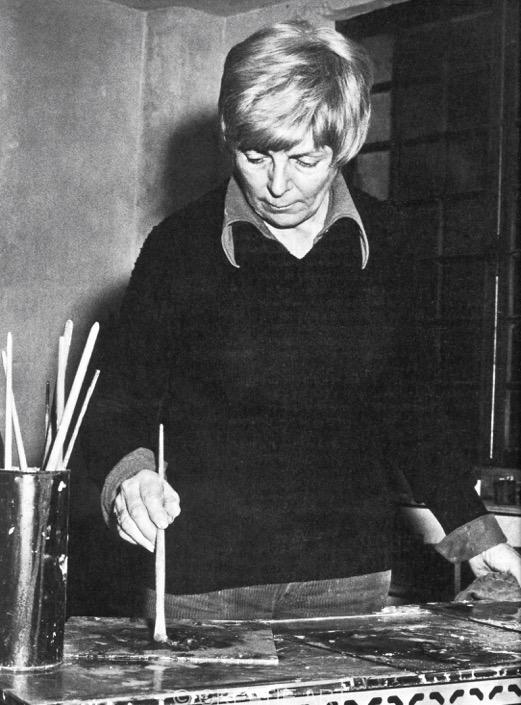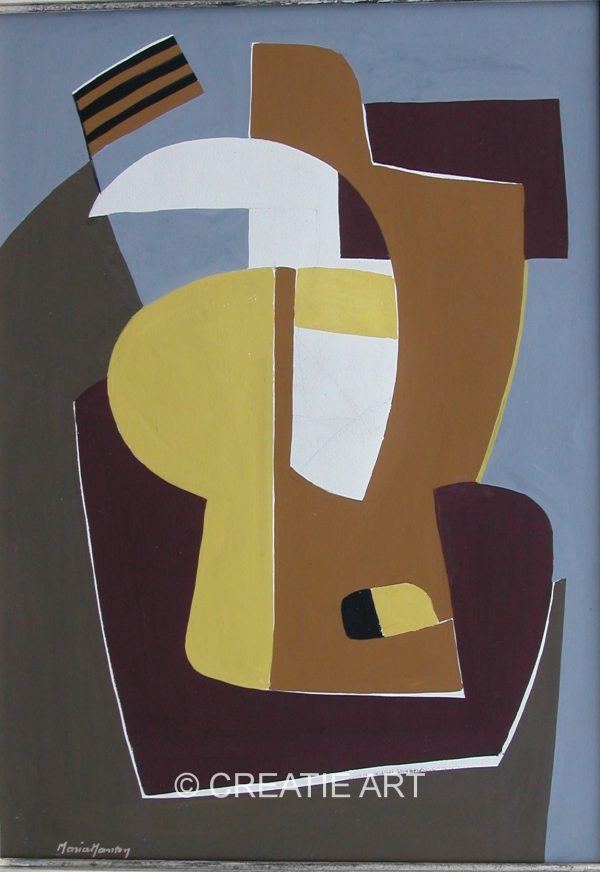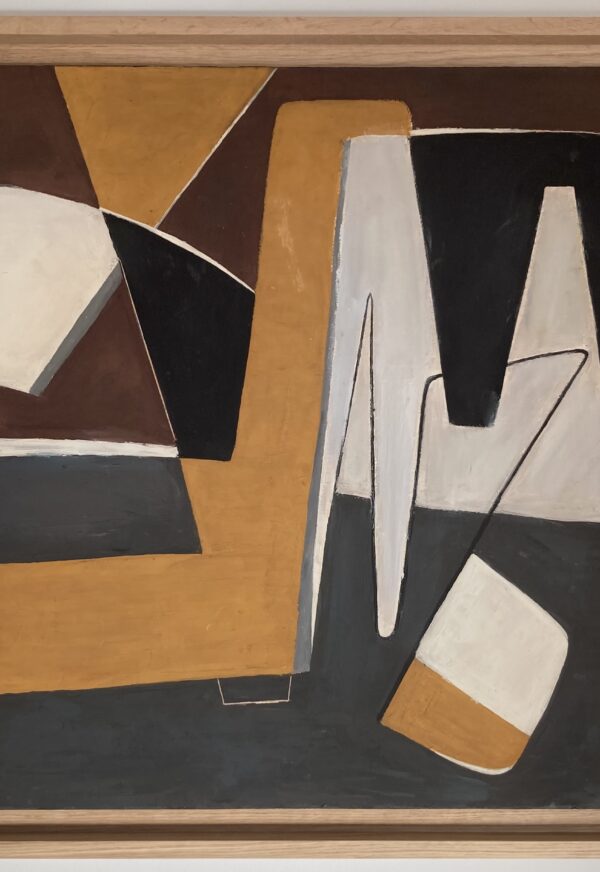Maria Manton is op 4 december 1910 in de Algerijnse plaats Blidah geboren uit Franse ouders. Haar vader was beroeps- militair en maakte regelmatig promotie, waardoor het gezin vaak verhuisde. Haar gehele schooltijd bracht zij door in Algiers. In het voortgezette onderwijs vatte ze grote belang- stelling op voor archeologie en in het bijzonder egyptologie en besloot ze geschiedenis te gaan studeren. Doordat ze getroffen werd door een ziekte die ruim een jaar aanhield, moest ze afzien van haar studieplannen. Haar moeder leerde haar tekenen om de verveling tijdens haar ziekte te verdrijven. Een bevriende schilder van de familie onderkende haar talent en adviseerde Maria om zich in te schrijven bij de École des Beaux-Arts in Algiers. Hoewel haar ouders niets in een artistieke carrière voor hun dochter zagen, schreef zij zich in 1936 toch in en volgde lessen in meerdere disciplines. Op de academie ontmoette zij in 1941 de schilder Louis Nallard. Deze was gemobiliseerd bij de meteorologische dienst in Tunesië, niet ver van de Algerijnse grens.
Maria Manton was in die tijd verbonden aan een legeronderdeel in Algerije en schuwde het avontuur niet toen zij zich in 1943 aanmeldde om een nieuw benoemde generaal te escorteren die met auto’s een tocht naar het oosten van Algerije ging ondernemen, waar contact gelegd werd met het Amerikaanse leger. Met een van de Amerikanen geleende Dodge verraste ze Nallard bij zijn onderdeel in Tunesië. Tijdens een verlof in 1944 huwden ze in Algiers, waar ze zich na de demobilisatie samen vestigden en waar ze in 1946 haar eerste solo-expositie had.
Aangetrokken door het kleurgebruik van Matisse en de wijze waarop Braque zijn schilderijen opbouwde, schilderde Maria portretten van familieleden, stillevens en landschappen.
In 1947 verhuisde het echtpaar naar Parijs. Hier begon Maria Manton onder invloed van het Kubisme en na kennismaking met het werk van Roger Bissières, Auguste Herbin en Alberto Magnelli, haar eerste abstracte werk. Al in 1948 nam ze deel aan een groepsexpositie in de Parijse galerie Colette Allendy en een jaar later hingen haar werken zij aan zij met die van Hans Hartung, Gérard Schneider en Pierre Soulages in de vooraanstaande, in naoorlogse abstracte kunst gespecialiseerde, Galerie Lydia Conti, waar ze in 1950 een eerste solo-expositie had, en op de Salon des Réalités Nouvelles. Naast exposities in Parijs trok haar werk internationale aandacht in de reizende Exhibition of Contemporary French Art, welke Rio de Janeiro, Sao Paolo en Buenos Aires aandeed en in tentoonstellingen in Nederland, België, Zwitserland, Italië, voormalig Joegoslavië, Algerije en de Verenigde Staten.
Van 1950 tot 1953 beheerden Nallard en Manton het Hotel du Vieux-Colombier in de nabijheid van Saint-Germain-des-Prés, dat werd bezocht door vele artiesten, zoals Serge Poliakoff die toen in zijn levensonderhoud voorzag door balalaika te spelen in Russische restaurants, Sydney Béchet en de beeldhouwer César.
Zowel Maria Manton als Louis Nallard waren vanaf 1948 nauw betrokken bij de Salon des Réalités Nouvelles als deelnemers, bestuurders (Maria was meer dan 30 jaar secretaris) en stimulators van jong talent. (De Salon des Réalités Nouvelles is de jaarlijkse tentoonstelling van de abstractie, die sedert 1946 in Parijs wordt georganiseerd door de kunstenaarsvereniging Réalités Nouvelles, welke vereniging ten doel heeft de promotie van non-figuratieve of abstracte kunst.) Maria Manton en Louis Nallard hebben samen veel gereisd, met name rondom de Middellandse Zee.
De stijl van Manton’s naoorlogse abstractie wordt gekenmerkt door de ononderbroken lijn, geometrie en harmonieus kleurgebruik. Overwegend Mediterrane tinten oker, rood, blauw en bruin, maar ook de grijs- en aardetinten van het analytisch kubisme. Vanaf eind jaren vijftig wordt haar stijl informeler en maken de aardkleuren plaats voor helder blauw, roze- en lilatinten.
Op 2 september 2003, vlak voor de opening van de tentoonstelling ‘Mère Algérie’ in het Musée de Villeneuve-sur-Lot, waarin werken van haar en andere kunstenaars met een band met Algerije waren opgenomen, overlijdt zij in Parijs.
Werken van Maria Manton bevinden zich in de collecties van ondermeer het Musée National d’Art Moderne à Paris (Centre Pompidou), het Musée d’Art Moderne de la Ville de Paris en het Musée National des Beaux-Arts d’Alger.
—————————————————————-
Maria Manton was born on December 4, 1910 in the Algerian town of Blidah of French parents. Her father was a professional soldier and was regularly promoted, which meant that the family moved often. She spent her entire school years in Algiers. In secondary education she became very interested in archeology and Egyptology in particular and decided to study history. Because she was struck by an illness that lasted for more than a year, she had to abandon her study plans. Her mother taught her to draw to relieve boredom during her illness. A painter friend of the family recognized her talent and advised Maria to enroll at the École des Beaux-Arts in Algiers. Although her parents did not see any interest in an artistic career for their daughter, she still enrolled in 1936 and took lessons in several disciplines. At the academy in 1941 she met the painter Louis Nallard. This was mobilized at the meteorological service in Tunisia, not far from the Algerian border.
Maria Manton was at that time attached to an army unit in Algeria and did not shy away from adventure when she signed up in 1943 to escort a newly appointed general who was going on a trip by car to eastern Algeria, where contact was made with the American army. With a Dodge borrowed from the Americans, she surprised Nallard at his unit in Tunisia. During a leave of absence in 1944, they married in Algiers, where they settled together after the demobilization and where she had her first solo exhibition in 1946.
Attracted by Matisse’s use of color and the way in which Braque constructed his paintings, Maria painted portraits of family members, still lifes and landscapes.
In 1947 the couple moved to Paris. Here, under the influence of Cubism and after becoming acquainted with the work of Roger Bissières, Auguste Herbin and Alberto Magnelli, Maria Manton started her first abstract work. As early as 1948 she took part in a group exhibition at the Parisian gallery Colette Allendy and a year later her works hung side by side with those of Hans Hartung, Gérard Schneider and Pierre Soulages in the leading Galerie Lydia Conti, specialized in post-war abstract art. where she had a first solo exhibition in 1950, and at the Salon des Réalités Nouvelles. In addition to exhibitions in Paris, her work attracted international attention in the traveling Exhibition of Contemporary French Art, which visited Rio de Janeiro, Sao Paolo and Buenos Aires, and in exhibitions in the Netherlands, Belgium, Switzerland, Italy, the former Yugoslavia, Algeria and the United States.
From 1950 to 1953, Nallard and Manton managed the Hotel du Vieux-Colombier near Saint-Germain-des-Prés, which was frequented by many artists, such as Serge Poliakoff who then supported himself by playing balalaika in Russian restaurants, Sydney Béchet and the sculptor César.
Both Maria Manton and Louis Nallard were closely involved in the Salon des Réalités Nouvelles from 1948 onwards as participants, directors (Maria was secretary for more than 30 years) and promoters of young talent. (The Salon des Réalités Nouvelles is the annual exhibition of abstraction, organized in Paris since 1946 by the artists’ association Réalités Nouvelles, which association aims to promote non-figurative or abstract art.) Maria Manton and Louis Nallard have traveled extensively together, especially around the Mediterranean.
The style of Manton’s post-war abstraction is characterized by uninterrupted lines, geometry and harmonious use of color. Predominantly Mediterranean shades of ochre, red, blue and brown, but also the gray and earth tones of analytical cubism. From the late 1950s, her style became more informal and the earth colors made way for bright blue, pink and lilac tones.
On September 2, 2003, just before the opening of the exhibition ‘Mère Algérie’ at the Musée de Villeneuve-sur-Lot, which included works by her and other artists with a connection to Algeria, she died in Paris.
Works by Maria Manton are in the collections of, among others, the Musée National d’Art Moderne à Paris (Centre Pompidou), the Musée d’Art Moderne de la Ville de Paris and the Musée National des Beaux-Arts d’Alger.



